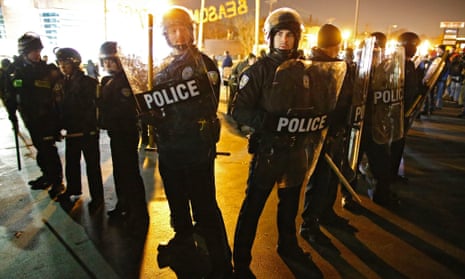Authorities around Ferguson, Missouri, have refused to make significant concessions to proposed “rules of engagement” from protesters, in advance of unrest expected to follow an announcement on whether a white police officer will be charged for killing a black 18-year-old.
In a formal response from police chiefs to a 19-point set of requests from a coalition of groups demonstrating over the death of Michael Brown, authorities agreed only to basic demands such as prioritising “preservation of human life”.
Requests for police to rule out using armoured vehicles, teargas and rubber bullets, as they did repeatedly in answer to unrest in August, were rejected by police chiefs. So was a call for journalists and legal observers not to be considered participants and to “be allowed to do their jobs freely”.
“If protesters are not violent, police will not be aggressive,” Francis Slay, the mayor of St Louis, said at a press conference in Clayton. “But if some protesters turn violent or threatening, police will respond to keep everyone safe.”
Protests are expected following the announcement of a decision by a state grand jury on whether officer Darren Wilson, who shot Brown dead on 9 August, should face criminal charges. There is a widespread assumption among demonstrators that he will not.
A spokesman for Bob McCulloch, the St Louis county prosecutor who is overseeing the process, said in an email to reporters on Friday “the grand jury is still in session”. While he began making logistical plans for an announcement of the decision, he offered no anticipated date or time.
The 19-point request was issued by the Don’t Shoot Coalition, which consists of about 50 protest groups. Officials said that while the list was discussed in five meetings or phone calls in recent weeks, there was “no negotiation” on any of the points. Police agreed to 10 and partially agreed to two others. But they declined to move on any of the protesters’ most contentious requests.
Slay said anyone engaged in civil disobedience following the announcement “will, in most cases, be given a chance to adhere to the law before being arrested”. He said occupations of public spaces may be permitted for longer periods than usual.
However, the response from the so-called unified police command – comprising chiefs from the St Louis metropolitan police, St Louis County police and Missouri state highway patrol – refused to rule out mass arrests and the containment tactic known as kettling. Chiefs also declined a request to be more tolerant of what protesters called “minor lawbreaking”, such as the throwing of water bottles, which has on past nights prompted a firm crackdown from police.
A request that “intimidation and harassment of protesters will not tolerated” met with a response from police that demonstrators “should renounce harassment of police officers and the release of personal information by protesters”.
Authorities were unable to explain why officers at the Ferguson police headquarters had on the previous two nights swiftly emerged in riot gear to deal with nonviolent protests. Five people were arrested on Wednesday night and three on Thursday.
Asked why the officers had responded immediately with such equipment, Daniel Isom, Missouri’s director of public safety, said: “I don’t know why. I can’t say why.” Asked if they had been incorrect to do so, he said: “I don’t know that they were incorrect.”
The response to the protesters’ requests was unveiled as Eric Holder, the US attorney general, announced that the Department of Justice was giving new guidance to regional police forces on “maintaining public safety while safeguarding constitutional rights”.
In a video message accompanying the announcement, Holder said law enforcement departments should “avoid needless confrontation” by paying attention to their policies and training and in “choosing the appropriate equipment and uniforms”.
Without naming Ferguson, he stressed that “the vast majority of law enforcement officers have honourably defended their fellow citizens” during recent events. Similarly, he said: “In most cases these demonstrations have been both meaningful and responsible and have brought vital issues to the attention of the public at large.”
However, Holder sought to remind demonstrators that the most successful protest movements in US history had been “those that adhere to nonaggression and nonviolence”.
Michael Brown Sr also urged protesters in a video message on Thursday to remain peaceful. Citing Brown’s request that “I don’t want my son’s death to be in vain,” Slay said at Friday’s press conference: “I’m here to tell you that it can’t be, and it won’t be.”
Isom added on Friday that officers engaged in training since Brown’s death had been taught “to try to work on restraint” and “to try to understand people’s perspective”. The military-style response to August’s demonstrations received broad criticism.
Earlier in the afternoon a small group of demonstrators staged a mock lynching from a tree opposite St Louis’ old courthouse, where the slave Dred Scott was denied freedom for him and his wife in 1847, in a case that would culminate 10 years later in a notorious ruling against the rights of African Americans by the US supreme court.
“People of colour are treated unjustly in this country in how they are processed and brutalised in the system by law enforcement,” said one of the protesters, Rae, who said she was 23 and lived in St Louis. “It’s all a lynching, and it’s a big mess.”

Comments (…)
Sign in or create your Guardian account to join the discussion